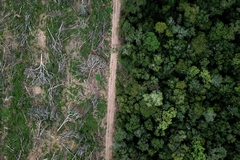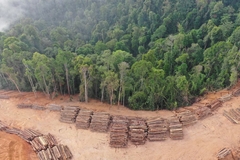Sustainable meat: Scientists find minor cutbacks to global beef production could “maximize climate benefits”
While environmentalists and scientists believe a “drastic” reduction of meat production is required to reduce emissions, a new analysis reveals that a smaller reduction by wealthier nations could also help combat climate change. Modest measures can remove 125 billion metric tons of CO2 from the atmosphere, which a New York University (NYU) study estimates would roughly equal three years’ worth of global emissions.
Minor cutbacks in higher-income countries, which account for nearly 13% of total production, can potentially reduce the land needed for cattle grazing. This would allow forests to regrow on pastureland naturally, the researchers note.
The study’s lead author, Dr. Matthew Hayek, assistant professor in the NYU Department of Environmental Studies, speaks to Food Ingredients First about how cattle and beef production could present an opportunity to fight climate change.
“Grazing livestock emit methane from their belches and nitrous oxide from their manure. Both are powerful greenhouse gases. And they also require a lot of land for grazing. That grazing occurs in different places, where it’s expanding into forests, like the Amazon, that causes emissions of CO2,” he says.

“If we can decrease their land use, or reduce our consumption, we can decrease the amount of land that we require to raise them. In some places, they graze native grasslands and shrublands. But in other places, native forests would quickly regrow if we weren’t grazing animals there. Those can suck up a lot of CO2 into plants and soils as they regrow.”
.jpg) NYU has produced maps that countries can use to visualize trade offs between beef and forest carbon, says Dr. Matthew Hayek, the study’s lead author. He believes that some restoration strategies could “maximize climate benefits” while minimizing changes to food supplies by focusing on regions with potentially high carbon sequestration in forests.
NYU has produced maps that countries can use to visualize trade offs between beef and forest carbon, says Dr. Matthew Hayek, the study’s lead author. He believes that some restoration strategies could “maximize climate benefits” while minimizing changes to food supplies by focusing on regions with potentially high carbon sequestration in forests.
The findings are published in the journal Proceedings of the National Academy of Sciences.
Targeting cattle efficiency
The researchers view high- and upper-middle-income countries as viable candidates for a reduction in beef production since they have some current pasture areas that do not produce much grass per acre or exist where grass grows only during a short growing season. They could also utilize areas that could grow vast forests that help sequester or absorb carbon.
This differs significantly from other regions, including sub-Saharan Africa and South America, where much more pasture can grow year-round, producing more animal feed per acre than northern countries.
Additionally, the study suggests ways lower-income regions could increase the efficiency of cattle feeding and raise them on grass to offset the minor loss in production from higher-income countries.
“This isn’t a one-size-fits-all solution,” Hayek emphasizes. “Our findings show that strategic improvements in the efficiency of cattle herds in some areas, coupled with decreased production in others, could lead to a win-win scenario for climate and food production.”
 Amount of edible pasture grasses and vegetation grown in each gridcell per year for grazing livestock (Image credit: Matthew Hayek and Johannes Piipponen).
Amount of edible pasture grasses and vegetation grown in each gridcell per year for grazing livestock (Image credit: Matthew Hayek and Johannes Piipponen).
Tracking pasture productivity
The team used remote sensing technology to track pasture productivity to estimate the climate benefits that reductions would yield.
“Pasture productivity is the amount of grass and other forages that can grow in each hectare of a pasture each year. To measure it, we used 20 years of satellite data with climate and terrain information to gauge how much grass the cattle could access,” explains Hayek.
“This was important to know, for every place on earth, how much pasture would be lost in order to restore native ecosystems. This is because our goal was to find the areas that would lose the least pasture production while restoring the most carbon.”
However, the team acknowledges that the analysis only reflects the proportion of beef production raised using forage from pasture. This excludes the proportion of beef raised from concentrated crop feeds (grain, oilseeds), cropland-grown forages (alfalfa, maize silage), or inedible crop residues (maize stover, husks) and other occasional feeds.
Agriculture restorations trade offs
While policy proposals for natural climate solutions and calls to restore ecosystems exist, the authors believe such strategies often fail to acknowledge agriculture-restoration trade offs.
 Higher and upper middle income countries could utilize areas that have potential to grow vast forests that help absorb carbon.They add that these ecosystem restoration proposals contrast with recent scientific work that has analyzed trade offs between carbon sequestration through restoration versus cropland productivity for food and animal feed. This led to the team focusing on the largest category of land use for beef production for the study, pasturelands.
Higher and upper middle income countries could utilize areas that have potential to grow vast forests that help absorb carbon.They add that these ecosystem restoration proposals contrast with recent scientific work that has analyzed trade offs between carbon sequestration through restoration versus cropland productivity for food and animal feed. This led to the team focusing on the largest category of land use for beef production for the study, pasturelands.
“This research was inspired by my past field research in ecology in New England and the Brazilian Amazon. In both places, I’ve seen firsthand examples of how quickly and abundantly forests can return when even a little bit of beef production is scaled back,” Hayeks tells us.
“Interestingly, Costa Rica is an example of a country that did this through the 1990s through a large-scale reforestation effort. They paid less-productive farmers to reforest their land. The result was them nearly doubling their forest area while still keeping the highest-yielding and more sustainable food producers in business.”
However, he flags that the “beef-for-forest trade off is not the same everywhere.” To tackle this, the team has produced maps that every country can use to “visualize similar trade offs between beef and forest carbon.”
He adds that the study’s findings could offer policymakers pathways to address both climate mitigation and food security concerns.
For instance, the maps can identify areas where policies could be prioritized to reduce beef production and hasten forest recovery by offering forest land conservation incentives or buyouts to beef producers.
Shifting away from meat
Hayek observes that while consumers like beef and likely will continue to do so, in most high-income countries like the US and Europe, consumption has “somewhat plateaued.”
Lowered meat consumption is also driving plant-based alternative sales, with 37% of all households in Germany, 33% in the UK and 19% in Spain buying plant-based meat at least once last year.
 Beef consumption in most high-income countries like the US and Europe has “somewhat plateaued.”“In these places, governments can let consumers know that there are benefits of shifting away from beef consumption, especially toward consuming healthy plant proteins.”
Beef consumption in most high-income countries like the US and Europe has “somewhat plateaued.”“In these places, governments can let consumers know that there are benefits of shifting away from beef consumption, especially toward consuming healthy plant proteins.”
“Governments can also support producers in making shifts to other forms of production, like beans and grains, support solar energy and conservation and ecosystem restoration programs,” he adds.
Meeting climate goals
The NYU team aims to create outputs and interactive maps tailored to different regions, especially for countries currently trading beef with one another, in the future, reveals Hayek.
“These data can help them know how much land their pastures occupy, where they are and what the opportunities are for maximizing carbon drawdown on those lands while minimizing losses to beef production. Farmers must be involved in these plans as well.”
“Countries like Denmark are currently planning sustainable agricultural and economic transitions for some of their least efficient livestock producers, all while strengthening food trade. We hope to provide tools that can help meet climate and food security goals simultaneously,” he concludes.











